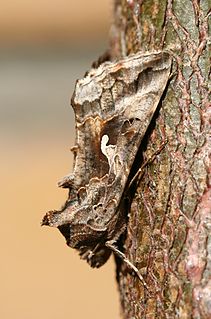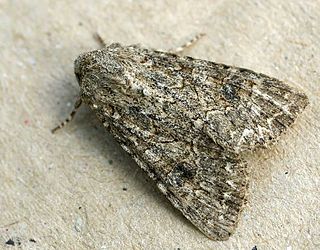This page is based on this
Wikipedia article Text is available under the
CC BY-SA 4.0 license; additional terms may apply.
Images, videos and audio are available under their respective licenses.

Noctuoidea is the superfamily of noctuid or "owlet" moths, and has more than 70000 described species, the largest number of for any Lepidopteran superfamily. Its classification has not yet reached a satisfactory or stable state. Since the end of the 20th century, increasing availability of molecular phylogenetic data for this hugely successful radiation has led to several competing proposals for a taxonomic arrangement that correctly represents the relationships between the major lineages.

Xestia is a genus of noctuid moths. They are the type genus of the tribe Xestiini in subfamily Noctuinae, though some authors merge this tribe with the Noctuini. Species in this genus are commonly known as "clays", "darts" or "rustics", but such names are commonplace among Noctuidae. Xestia moths have a wide distribution, though they most prominently occur in the Holarctic.

The Noctuinae are a subfamily of the family Noctuidae. The larvae of many species feed on roots or stems of various grasses. Some are generalist feeders which makes them potential pests.

The Calpinae are a subfamily of moths in the family Erebidae. This subfamily includes many species of moths that have a pointed and barbed proboscis adapted to piercing the skins of fruit to feed on juice, and in the case of the several Calyptra species of vampire moths, to piercing the skins of mammals to feed on blood. The subfamily contains some large moths with wingspans longer than 5 cm (2 in).

Acontiinae is a subfamily of moth family Noctuidae.

Plusiinae is a smallish subfamily of the moth family Noctuidae. As the Noctuidae appear to be a paraphyletic assemblage, the Plusiinae may eventually be raised to family status.

Agaristinae is one of the larger subfamilies of moths in the family Noctuidae. Its internal phylogeny and many genera are in need of review.

Hadeninae is a subfamily of moth family Noctuidae. The limits between this group and the Condicinae and Noctuinae are still not precisely known, with 3 major and partially conflicting revisions since 2006. Some include the noctuid subfamilies Eriopinae and Psaphidinae here as tribes Eriopini and Psaphidini, yet the former are not even recognized as distinct tribe by all sources. Another proposed treatment is to include the group within an expanded Noctuidae.

Murlough Nature Reserve lies on the coast of County Down in Northern Ireland, situated close to Newcastle. It has views of Slieve Donard, the highest peak in the Mourne Mountains and Dundrum Bay. Its 6,000-year-old sand dune system has been managed by the National Trust since 1967, when it became Ireland's first nature reserve. Grid ref: J414351.

Acronictinae is a large subfamily of moths in the family Noctuidae.
Drasteria is a genus of moths in the family Erebidae.
Megalographa monoxyla is a moth of the family Noctuidae. It is found only in Peru and Bolivia and has a narrow distribution in the Andes.
Megalographa bonaerensis is a moth of the family Noctuidae. It is found from southern Brazil and Paraguay southward to northern Argentina and Chile.

Stephens' gem or the bilobed looper is a moth of the family Noctuidae. It is widely distributed from the southern parts of the United States, south through Central America and South America up to Argentina. As a seasonal migrant it occurs even farther north into the northern parts of the United States and southern Canada. Here it usually produces one or two generations each summer, but rarely survives the winter this far north. It also occurs in the Hawaiian Islands but it is unknown if the species occurs there naturally or was introduced. It has also been recorded in Great Britain, where it is either a rare migrant or introduced by travel on ships crossing the Atlantic.
Megalographa talamanca is a moth of the family Noctuidae. It is known only from the Talamanca Mountain Range of central Costa Rica where it has been collected at elevations above 3,100 meters in oak dominated cloud forests.

The Erebidae are a family of moths in the superfamily Noctuoidea. The family is among the largest families of moths by species count and contains a wide variety of well-known macromoth groups. The family includes the underwings (Catocala); litter moths (Herminiinae); tiger, lichen, and wasp moths (Arctiinae); tussock moths (Lymantriinae), including the arctic woolly bear moth ; piercing moths ; micronoctuoid moths (Micronoctuini); snout moths (Hypeninae); and zales, though many of these common names can also refer to moths outside the Erebidae. Some of the erebid moths are called owlets.

The Erebinae are a subfamily of moths in the family Erebidae. Erebine moths are found on all continents except Antarctica, but reach their greatest diversity in the tropics. While the exact number of species belonging to the Erebinae is not known, the subfamily is estimated to include around 10,000 species. Some well-known Erebinae include Underwing moths (Catocala), and Witch moths (Thermesiini). Many of the species in the subfamily have medium to large wingspans, up to nearly 30 cm in the White Witch moth, which has the widest wingspan of all Lepidoptera. Erebine caterpillars feed on a broad range of plants; many species feed on grasses and legumes, and a few are pests of castor bean, sugarcane, rice, as well as pistachios and blackberries.
Max Gaede was a German engineer and entomologist of international fame who described several hundred of new species of Lepidoptera, mainly African Noctuidae.
Emilio Berio was an Italian entomologist and lawyer.















